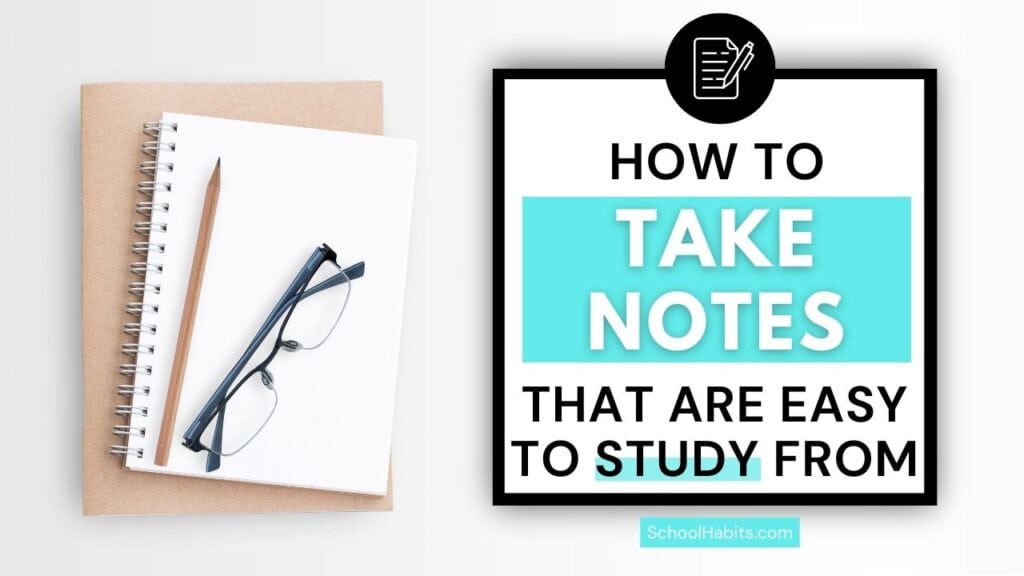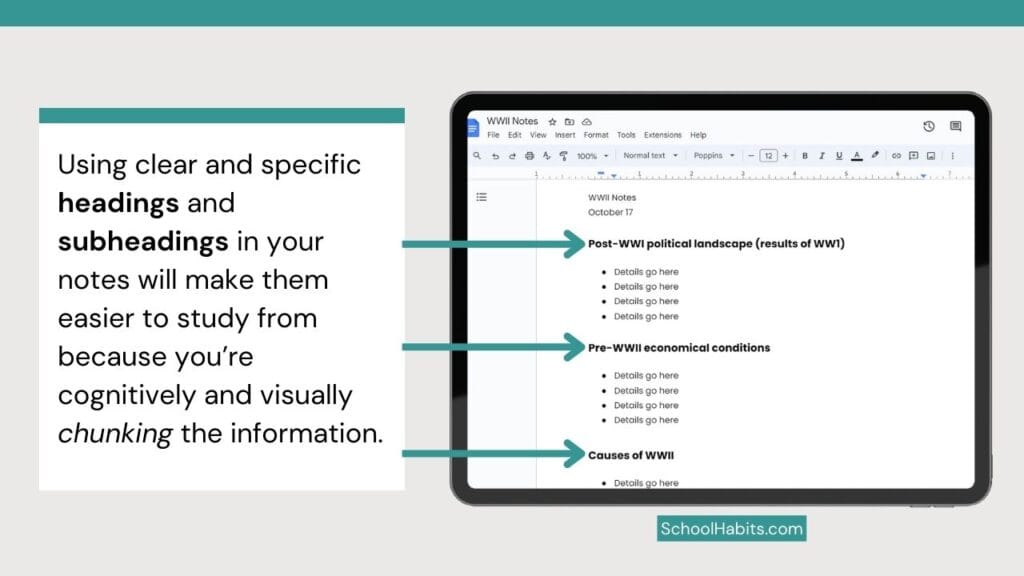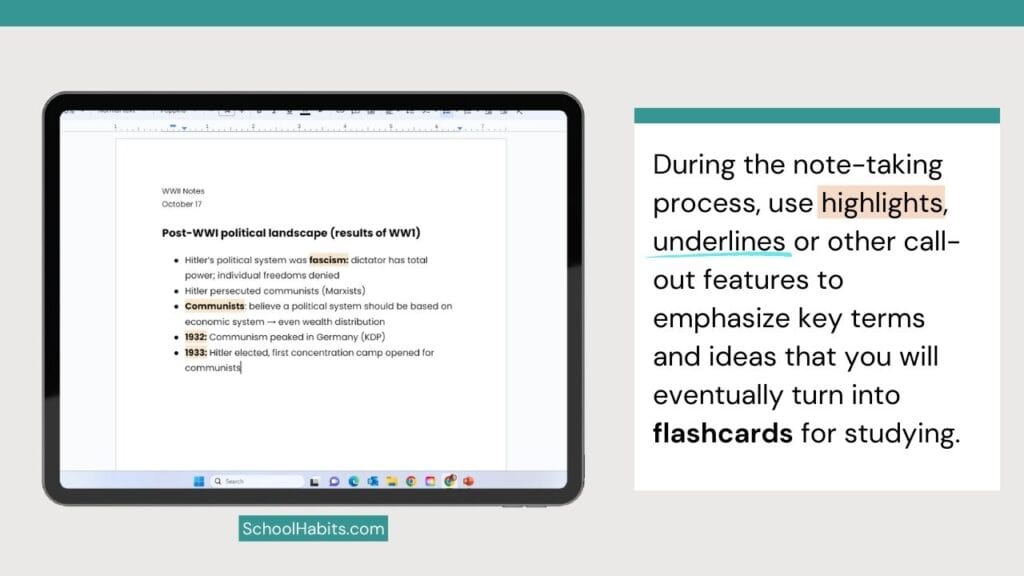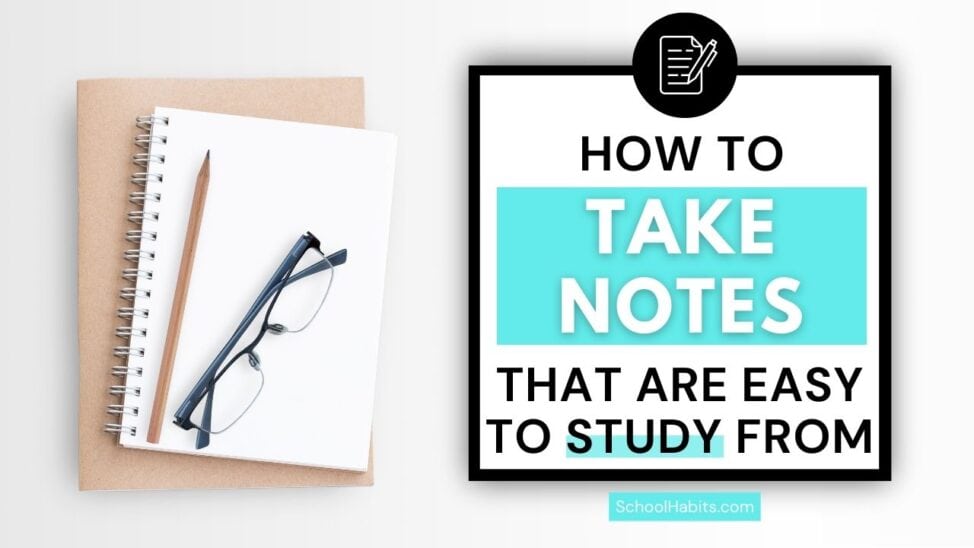
By Katie Azevedo, M.Ed.
The entire point of taking notes is so that they become something useful to you. If you’re taking notes that are disorganized, unclear or incomplete, they’re not useful, which is a waste of your time.
In this blog post, I teach you how to take notes that are easy to study from. I give you 4 unique note-taking tips that will drastically increase how useful your notes are when you need them the most: for studying.
(Prefer to watch a video version of these tips? I’ve linked the video at the bottom of the post.)
You’ve been taking notes wrong
I know that some teachers turn note-taking into assignments. For example, your homework might be to read and take notes on chapter 8 in your textbook. In this case, you might be tempted to fill your notebooks with “notes” just to get credit for the assignment.
I get it. You can technically get away with doing that in the moment. But do not do this.
When you don’t have an actual note-taking strategy, and when you just take notes to satisfy your teacher, your notes become meaningless. While you might think that doing this is easier, you’re actually making your life much harder in the end because when it comes time to study for a test, you have no good notes to study from, and you hardly know the material.
If you really want to up-level your note-taking strategy, you should know these 3 note-taking secrets of straight-A students.
Note-taking has two functions:
- Writing down information, whether from a textbook or lecture class, helps you understand and remember what you’re learning.
- Taking notes the right way lets you turn your notes into an easy study resource for tests and quizzes.
When you don’t take notes with an actual purpose, and when you don’t know how to take notes that are easy to study from, you waste your time writing them and you make it harder to study.
How to take notes that are easy to study from: 4 note-taking tips
Note-taking is one of my most written-about topics on my blog. At the bottom of this tutorial, I include links to my top note-taking resources so that you can complete your note-taking strategy beyond what you read about here.
Below, you’ll find 4 tips for taking and designing your notes so that they are useful to you from the very beginning. When you take notes with the intention of turning them into future study resources, studying becomes so much easier.
1. Don’t write down what you don’t understand.
If the goal of taking notes is so that they are easy to study from, your notes need to make sense to you. If you write down definitions, concepts and other material that you don’t understand, your notes become pointless.
When you take notes on challenging material, it’s important that you pause to think about what you’re writing before you write it.
- Do you understand what you just read in the textbook?
- Do all definitions make sense to you?
- Are you understanding what your teacher is explaining in class?
- Are you thinking about what you’re writing down before you write it?
If the answer to any of those questions is no, then you need to reach a deeper level of comprehension before you write anything in your notebook.
How do you reach a deeper level of understanding?
- Raise your hand in class and ask for clarification during the lecture
- Google concepts that your textbook does a poor job explaining
- Watch a YouTube video that gives you a visual
- Use these strategies that are practically guaranteed to help you figure it out
How does this make your notes easier to study from?
When you eventually use your notes to make flashcards or study guides, you won’t have to go back and try to interpret your notes. When your notes make sense to you – from the beginning – you can just turn them into study resources without having to reteach yourself the material.
2. Put all information into your own words.
Whether you’re taking notes from a textbook or writing down what your teacher is saying during class, always use your own words. I know that sometimes it’s easier to just copy exactly what you’re reading or hearing, but rephrasing all information into your own words is the best way for your brain to make sense of it.
How does this make your notes easier to study from?
When you take someone else’s words (your teacher or an author) and try to restructure the definitions or concepts into your own language, you’re forcing yourself to understand the original idea. If you don’t understand a textbook definition, you’ll never be able to rephrase it into your own language, right? That’s feedback you don’t want to ignore. So putting information into your own words forces you to understand everything you’re learning or hearing before you even write it down.
3. Use clearly defined headings and sections.
If you use clearly defined headings and sections in your notes, the notes will be much easier to study from or make study resources from when the time comes.
Whether you’re taking 2-column notes, using the Cornell note-taking method, or using a simple outline strategy, you should structure your notes so that all relevant information falls under clear headings or subheadings. You can create as many headings, subheadings and sections as you need to.
Note: If you take digital notes, you definitely want to know these 5 tips for taking digital notes.

For example, if you take notes on World War II, you might have multiple headings in your notes like the following:
- Post WWI political landscape
- Pre-WWII political conditions
- Causes of WWII
- Key events during WWII
- Post-WWII reconstruction
Under each category, you would have multiple details with information about each topic. You could study one category at a time until you’re ready to move on to the next chunk. When you organize your notes this way, you’re creating context for the information you’re learning about. Our brains like details when they’re grouped together with other similar details so we can visualize the larger picture.
Tip: It’s okay to go back and add headings or subheadings to your notes at a later point.
How does this make your notes easier to study from?
When you organize your notes by creating clear headings and subheadings for each new subject, you end up with notes that are easy to study from. If your headings are clear and specific, you’ll be able to study one chunk or one “category” at a time, which is an effective way to learn material.
4. Create your notes with flashcards in mind.
It’s a smart note-taking strategy to intentionally design your notes to be easily turned into flashcards when it’s time to study. When you take notes, be on the lookout for key terms, dates, concepts and other material that will likely end up on a future flashcard and mark it in some way.
You can use a highlighter, a star, a colored underline – anything that will make those terms and concepts easy to spot when you sit down to make flashcards from your notes.
If you’re using a 2-column method or the Cornell method, you’re already kind of doing this, as the information you put in the left column is essentially what you would put on one side of a flashcard. But you can still take this a step further and mark (highlight, underline, etc.) key terms and concepts in the right column.

How does this make your notes easier to study from?
When you take and design your notes with flashcards in mind, you quicken the process of making your study materials (flashcards). Instead of having to read through all your notes to find material to put on your flashcards, you can simply flip through your notes to find the parts that you highlighted or marked in some way.
Additional note-taking resources
- How to take notes from a textbook
- How to take notes from a video
- 7 note organization tips for students
- How to take notes in a lecture class

